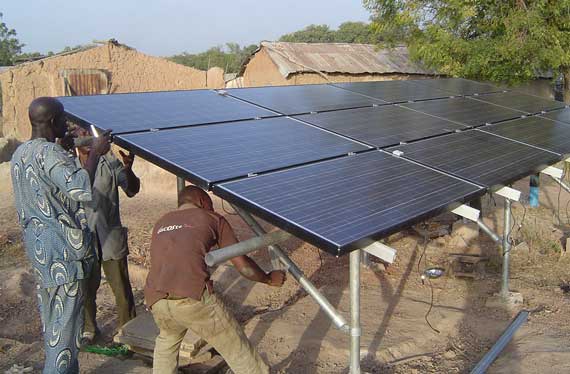Finding water in the sun
An innovative multiyear project in West Africa shows promise for economically and environmentally sustainable solar irrigation systems.
An innovative multiyear project in West Africa shows promise for economically and environmentally sustainable solar irrigation systems.
Like many areas of sub-Saharan Africa, northern Benin suffers from a six-month dry season during which agricultural productivity declines sharply. One potential solution to providing water during the dry season for this small West African nation involves the sun.
Solar-powered drip irrigation systems can significantly enhance household incomes and nutritional intake of villagers in Benin and other arid regions, according to research by Stanford's Center on Food Security and the Environment (FSE). The project, a partnership with the Solar Electric Light Fund (SELF), initially funded by the Stanford Woods Institute for the Environment Environmental Venture Projects program, has found that solar-powered pumps that tap deep wells provide a cost-effective way of delivering much-needed irrigation water, particularly during the long dry season.

Men install solar power array to power irrigation system in Dunkassa, Benin.
Up to
$8 billion in estimated yearly agricultural losses due to drought
"The economic benefits of these irrigation systems are clear, but the health benefits are also very encouraging," said FSE Director Rosamond L. Naylor, the William Wrigley Professor in the School of Earth, Energy & Environmental Sciences.
The Stanford project measures the impact of new solar-powered drip irrigation systems in villages in Benin's Kalalé district. Each system, financed and installed by SELF, is used by a local women's agricultural group, which typically consists of 30 to 35 women who share the maintenance costs of the new irrigation technology. In rural Benin, women and girls traditionally are responsible for hauling water by hand, often from very long distances. The solar-powered irrigation systems were designed to free them from hauling water to grow vegetable crops, particularly during the dry season.
Naylor and FSE fellow Jennifer Burney designed a multiyear survey to measure the impacts of a small pilot subset of solar market gardens. Naylor is a senior fellow at the Stanford Woods Institute and the Freeman Spogli Institute for International Studies.
Among other findings, Naylor and Burney discovered that in villages irrigated with solar-powered systems, vegetable intake increased to three to five servings per day – the U.S. Department of Agriculture's recommended daily allowance – with most of the improvement taking place during the long dry season.
The project, which recently expanded to eight more villages, is looking more closely at specific health indicators like children's height, weight, anemia rates and frequency of illness. "We know that solar market gardens provide families with more food and more diverse diets," Naylor said. "Now we want to understand exactly how this is improving overall health."
The ongoing project involves a series of studies on solar-powered irrigation systems' health and economic impacts, sustainability and potential financing.